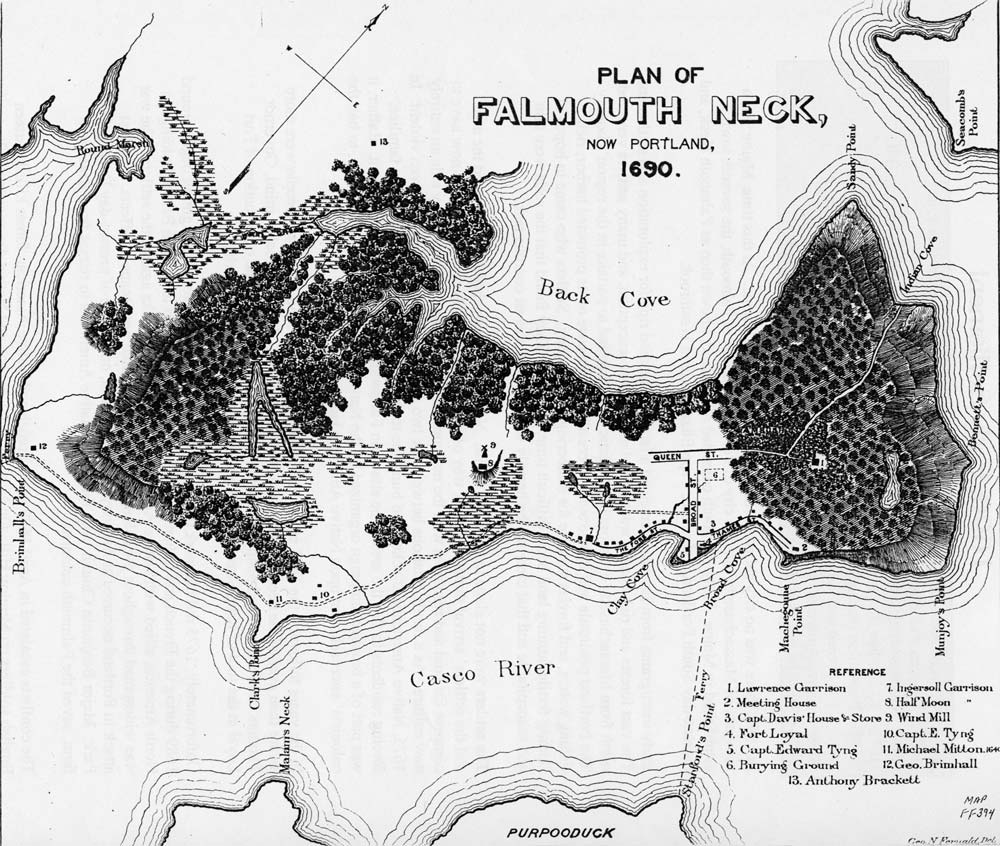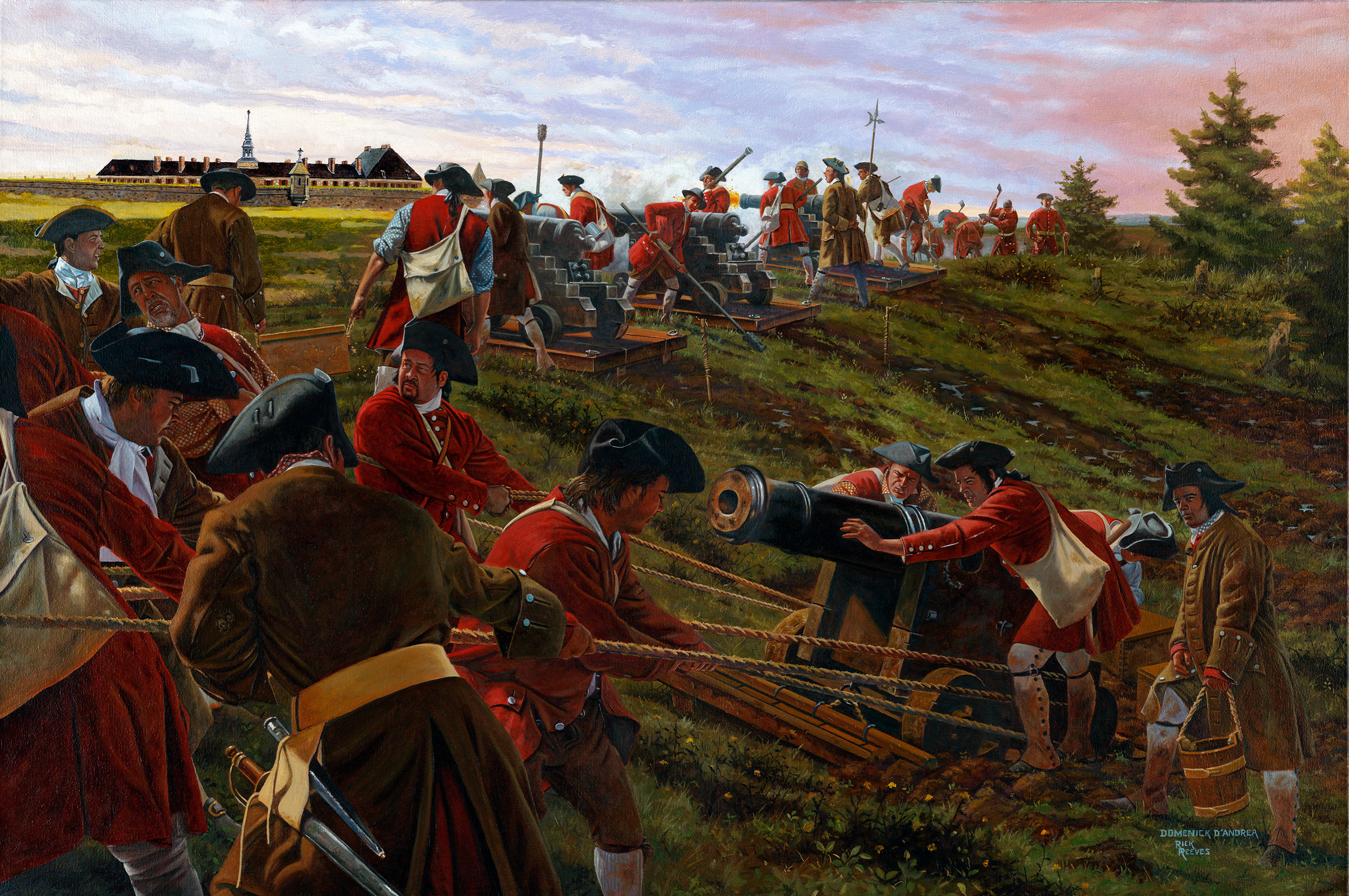Settlement of the Province of Maine
The National Guard traces its roots from the first militia musters held by the English colonists in North America. In 1607, Captain George Popham and over a hundred colonists established a settlement at the mouth of the Kennebec near Phippsburg. The colony built a fort for their defense but sailed back to England in 1608. Fort Popham, a Civil War fortification, stands near this site and is named in honor of Captain Popham. Small settlements continued throughout the early 1600s, with more and more colonists settling in southern Maine. Larger settlements centered on the present day towns of Portland and York. In 1622, the settlements were organized into the Province of Maine by a land patent from the Crown, named in honor of the queen who held an estate of the same name in France.
Sir Ferdinando Gorges attempted to establish a chartered colony under his son, Thomas, in Maine and in 1640 the proprietary colony of Gorgeana was founded, with Agamenticus (York) as its capital. The charter for the colony authorized its leaders to, “erecte, rayse, and build such and soe many Forts, Fortresses, Platforms, and other fortificacons whatsoever and the same and every of them to fortifie with men and all manner of ammunicion for the safetie of said Incorporacon.” The colony’s marshal was to have command and management of the militia.
Still, the population of Maine was so small that militia musters did not take on the communal tone that they would later. Much of the population lived at quite a distance from their neighbors; one man wrote that he lived “two Muskett shotts” distance from his closest neighbor. The colonists were persistently threatened by attack from French war parties from Canada accompanied by their American Indian allies. Raids were common, as Maine was the avenue of approach from French Canada to the English colonies in Massachusetts. In addition, France contested the control of northern and western Maine with England.
Because of this threat, many settlers in southern Maine wished to be incorporated into the Massachusetts Bay Colony to the south. There was considerable resistance to this as many of the settlers in Maine were Anglican, a religion not tolerated by the Puritans of Massachusetts Bay. For its part, Massachusetts Bay saw the Province of Maine as a threat to its own borders and aggressively pursued acquiring it. They finally succeeded in 1652, when they forcibly took possession of the Province of Maine as the “fifth shire, York County.”
Formation of the Militia in Maine
The York Company of militia was brought into the Massachusetts Bay Colony militia system on November 22, 1652. The Wells and Saco Companies followed on July 5, 1653. On July 14, 1658, the Scarborough Company was established. By May 31, 1671, the population had reached a density level where an entire regiment could be established: the York County Regiment of Militia. Major Nicholas Shapleigh was appointed the first commander of the York Regiment. His duty was to meet with the company officers and ensure that the soldiers of the regiment were well-armed, equipped, and disciplined. The Kittery Company was added on May 7, 1673, and additional companies from settlements in present-day York, Cumberland, Sagadahoc, and Lincoln Counties were added over the decades. May 31, 1671 can properly be considered the birthday of the Maine National Guard.
In 1676, Massachusetts’ claim to Maine was overturned by the English courts, but the Massachusetts Bay Colony removed all dispute in 1692 by purchasing Thomas Gorges’ patent to the province of Maine.
Colonial Conflicts
The summer of 1675 brought the first conflict that would depopulate much of Maine: King Phillip’s War. Brutal fighting with the Wabenaki Confederacy of tribes from 1675-1678 brought a negotiated peace that would last until 1689. During this war, much of the coastline was entirely depopulated. The militia companies were often called out in this conflict as Wells, Saco, Scarborough, and Falmouth were all frequent targets of enemy raids and incursions. In 1675, a force was established at Black Point (Scarborough) as the “Maine Guard,” the first such use of the term. Many of the first captains and lieutenants of the militia were killed in King Phillip’s War.
During this era, commanders of the militia companies tended to also be the deputies to the District of Maine’s General Assembly, held in York as the capital of the district. Some were military officers from Boston who had campaigned in Maine during King Phillip’s War and some were local men who had won the trust of their community during those desperate times.
In 1682, the General Assembly agreed to construct a fort in Falmouth (Portland) for the protection of the settlement. It was paid for by taxing the mills of the district and was constructed at the present-day site of the intersection of Commercial and India Streets. This earth and timber structure was given the name Fort Loyal.

In 1689, warfare between the English and the French again threatened Maine’s borders. Raids and counter-raids characterized this conflict, known as King William’s War. Most towns and communities had a garrison inside a fortification at this point. A substantial enemy force was defeated at Casco Bay (Portland) in 1689 by Massachusetts and local militia, but the French and Wabenaki returned the next year, lay siege to Fort Loyal, and massacred the population. Salmon Falls (Berwick) was also destroyed. The garrisons and settlements at Cape Elizabeth and Scarborough withdrew to the south. York was savagely attacked in 1692, as was Wells. During a siege in Wells that year from June 9-10, militia defenders fought off a large force of French and Wabenaki fighters. Women of the town supplied ammunition and in some places acted as gunners on the cannon. The attackers were entirely defeated. Fighting continued on and off throughout Maine for the next ten years.
In 1693, Massachusetts passed new laws governing the militia. All white male inhabitants between the ages of 16 and 60 were to be enrolled in the militia, to be armed and equipped with a musket and sword, and organized into companies of 60 men each to meet once a year for four days of training. These companies would be in turn organized into regiments, with regimental musters every three years. Officers were appointed by the commander-in-chief and the Council in Boston, while company commanders appointed their non-commissioned officers.
1703 brought new fighting, dubbed Queen Anne’s War, lasting until 1713. Militia service and frontier fighting became a tradition for Maine men as each farm and hamlet needed to have the organic means for defense. Fighting resumed again in Lord Dummer’s War from 1721-1727. The militia had grown in experience and confidence, enough to hold their own in Dummer’s War.
Around 1735, York County was large enough to hold two militia regiments, a western (York) and eastern (Falmouth).
When England and France went to war again in 1744 (King George’s War), the Maine militia was strong enough to send troops to partake in the New England militia expedition against the French fortress of Louisbourg on Cape Breton. The expedition was under the overall command of Colonel William Pepperell from Kittery, commander of the western regiment of the York County militia, who was given the temporary rank of lieutenant general. The commander of the naval forces was Captain Edward Tyng of Falmouth (Portland). Pepperell’s third in command was Colonel Samuel Waldo, commander of the eastern regiment of York County, given the temporary commission of brigadier general. Maine provided three regiments of infantry for this expedition, one third of all the Massachusetts troops. The fortress was taken on June 16, 1745 after a six-week siege. This was a notable event because it was the first time an all-militia force had independently taken a fortress of this size in North America.

The last colonial war was the French and Indian War, 1754-1763. Very little military action took place in Maine during this conflict, with most fighting consisting of small raids and counter-raids near Gray, Dresden, Newcastle, and North Yarmouth. But the war would have serious consequences for Maine’s military. Great Britain finally took control of Canada from the French and made Halifax, Nova Scotia a major port for the Royal Navy and a base for their army. Ten years later, as rebellion gripped the colonies, patriots in Maine found themselves opposing a very angry Britain on the frontier of the colonies.
In 1760, York County divided, giving rise to Cumberland County and Lincoln County. On June 21, the Cumberland County Regiment of Militia was constituted out of the eastern regiment of the York County regiment, which exists today as the 133rd Engineer Battalion, with headquarters in Brunswick.
Read more about early warfare in Maine here: "Firefight in the Park"